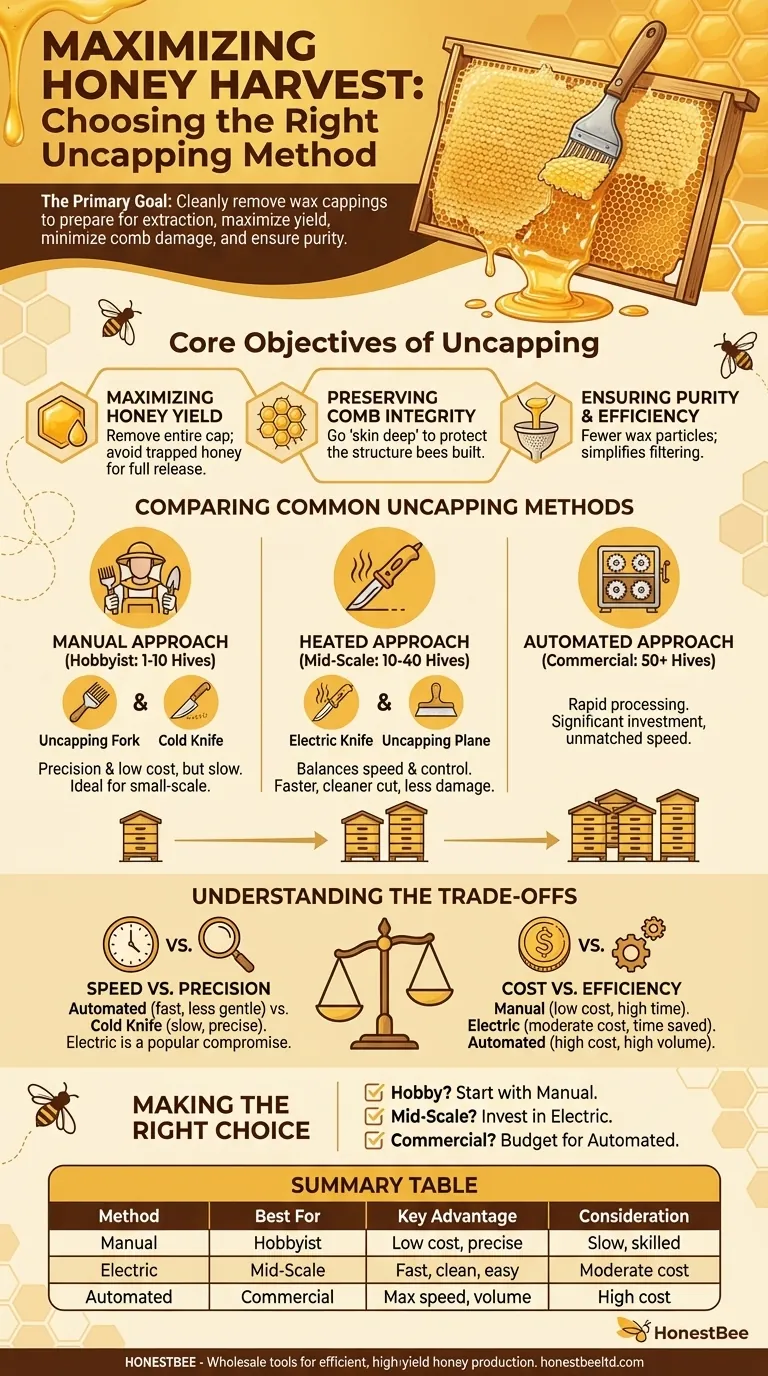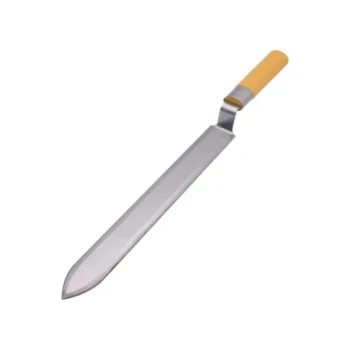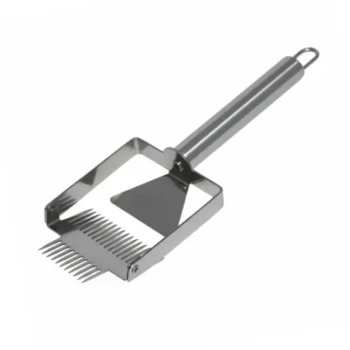The primary goal when choosing an uncapping method is to cleanly and efficiently remove the wax cappings from a honey frame. This prepares the frame for extraction while maximizing your honey yield, minimizing damage to the comb, and reducing the amount of wax that needs to be filtered from the final product.
The question isn't which uncapping method is "best," but which is best for you. Your choice will be a direct trade-off between the scale of your operation, your budget, and the time you are willing to invest.

The Core Objectives of Uncapping
Before comparing tools, it's essential to understand the specific outcomes you are trying to achieve. Every effective uncapping method aims to balance three key objectives.
Maximizing Honey Yield
A successful method removes the entire wax cap, ensuring no honey is left trapped in the cells. Incomplete uncapping directly translates to lost honey that will not be released during extraction.
Preserving Comb Integrity
The goal is to slice off only the wax cappings, going "skin deep." Cutting too deeply into the comb not only wastes honey but also damages the structure that the bees worked hard to build, forcing them to expend significant energy on repairs.
Ensuring Purity and Efficiency
A clean, precise cut results in fewer wax particles mixing with your honey. This simplifies the filtering and straining process later, saving you time and improving the clarity of your final product.
Comparing Common Uncapping Methods
The right tool depends entirely on the number of hives you manage. What is efficient for a hobbyist is impractical for a commercial operation.
The Manual Approach: Knives and Forks
For small-scale beekeepers, manual tools offer precision and low cost.
An uncapping fork or scratcher is used to pierce and lift the cappings. This is precise but slow, making it ideal for a few frames or for touching up low spots missed by a knife.
A cold knife requires a gentle, sawing motion to slice through the wax. It provides excellent control but demands more technique and effort than heated options.
The Heated Approach: Electric Knives and Planes
Heated tools are the standard for most mid-sized operations, balancing speed with control.
An electric uncapping knife has a heated blade that melts through the wax as it cuts. This makes the process faster, easier, and results in a much cleaner cut with less comb damage.
An uncapping plane is similar, offering a wider cutting surface that can uncap large sections of a frame in a single pass.
The Automated Approach: For Commercial Scale
When managing 50 or more hives, manual methods become a significant bottleneck.
Automated uncappers use spinning blades, flails, or heated wires to process frames rapidly. These systems are a major investment but are a necessity for any commercial-grade honey operation where time is money.
Understanding the Trade-offs
No single method is perfect. Your decision involves balancing competing priorities.
Speed vs. Precision
Automated systems are unmatched in speed but can be less gentle on the comb. A careful hand with a cold knife offers maximum precision but is by far the slowest method. An electric knife is the most popular compromise, offering good speed with minimal comb damage.
Initial Cost vs. Long-Term Efficiency
A simple uncapping fork is inexpensive, but the time it costs you adds up over many frames. An electric knife is a moderate investment that pays for itself in time saved for anyone with more than a few hives.
The Learning Curve
Using a cold knife effectively requires practice to avoid gouging the comb. In contrast, an electric knife is more intuitive, as the heat does most of the work, allowing the blade to glide easily.
Making the Right Choice for Your Apiary
Select your tool based on a realistic assessment of your needs and scale.
- If your primary focus is managing a few hobby hives: Start with a simple uncapping fork or a cold knife to maximize control and minimize cost.
- If your primary focus is efficiently harvesting from 10-40 hives: Invest in an electric uncapping knife to drastically reduce your processing time.
- If your primary focus is running a commercial-scale operation: Budget for a semi-automated or fully automated uncapping machine to handle the volume.
Ultimately, the right uncapping tool is the one that best aligns with the scale of your apiary and the value of your time.
Summary Table:
| Method | Best For | Key Advantage | Consideration |
|---|---|---|---|
| Manual Knife/Fork | Hobbyists (1-10 hives) | Low cost, high precision | Slow, requires skill |
| Electric Knife/Plane | Mid-Scale (10-40 hives) | Fast, clean cuts, easy to use | Moderate investment |
| Automated Uncapper | Commercial (50+ hives) | Maximum speed for high volume | High initial cost |
Ready to choose the right uncapping tool for your apiary's scale?
At HONESTBEE, we supply commercial apiaries and beekeeping equipment distributors with the wholesale-grade tools needed for efficient, high-yield honey production. Whether you're scaling up to an electric knife or investing in a commercial uncapping system, we provide the durable equipment that protects your comb and maximizes your harvest.
Contact HONESTBEE today for wholesale pricing on uncapping equipment tailored to your operation's size and goals.
Visual Guide

Related Products
- Stainless Steel Dual Blade Uncapping Plane
- Professional Stainless Steel Double-Sided Honey Uncapping Knife
- Professional Compact Multi-Function Uncapping Knife for Beekeeping
- Adjustable Stainless Steel Honey Uncapping Fork with Scraper for Beekeeping
- Professional Honey Uncapping Roller for Efficient Harvesting
People Also Ask
- How do you encourage bees to cap honey? Optimize Hive Conditions for a Perfect Harvest
- What is the overall recommendation for beginner beekeepers regarding uncapping tools? Master Your First Honey Harvest
- What is an uncapping plane, and how does it differ from an electric knife? Precision vs. Speed for Beekeepers
- What is an uncapping knife used for? A Guide to Efficient Honey Harvesting
- What is the best way to uncap honey? Find the Perfect Tool for Your Hives



















